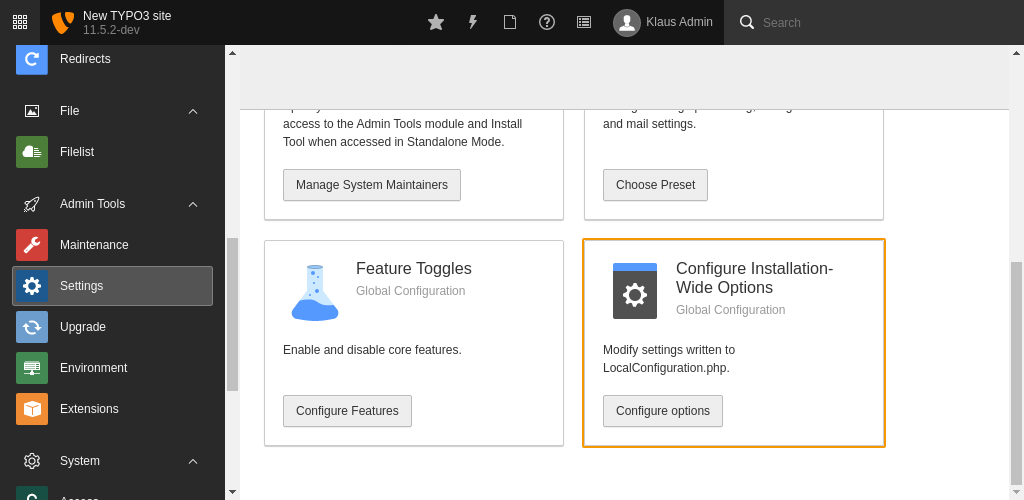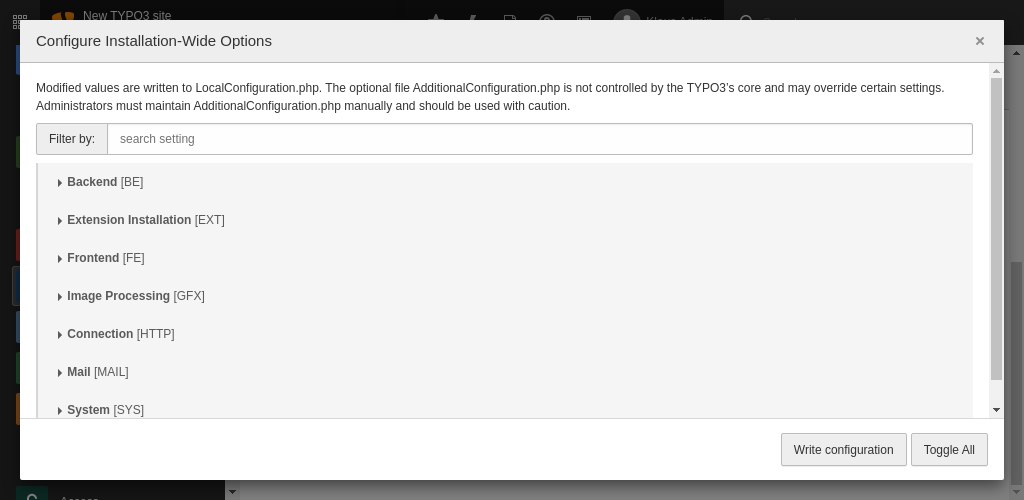System configuration and the global settings.php
System configuration settings, such as database credentials, logging levels, mail
settings, etc, are stored in the central file system/.
This file is primarily managed by TYPO3. Settings can be changed in the Admin Tools modules by users with the system maintainer role.
The file system/ is created during the
setup process.
Configuration options are stored internally in the global array
$GLOBALS.
They can be overridden in the file system/. Some settings
can also be overridden by installed extensions. They are then defined in extension file
ext_localconf.php
for the frontend and backend contexts or in the extension
ext_tables.php
for the backend context only.
This chapter describes the global configuration in more detail and gives hints about further configuration possibilities.
Table of contents
System configuration files
The configuration files settings.php and
additional.php are located in the directory
config/system/ in Composer-based
installations. In Classic mode installations they are located in
typo3conf/system/.
This path can be retrieved from the Environment API. See getConfigPath() for both Composer-based and Classic mode installations.
Global configuration is stored in file config/ in
Composer-based extensions and typo3conf/ in Classic mode
installations.
This file overrides default settings from
typo3/.
File config/system/settings.php
config/system/settings.php
-
- Scope
- project
- Path (Composer)
- config/system/settings.php
- Path (Classic)
- typo3conf/system/settings.php
The most important configuration file is
settings.. It contains local settings in the main global PHP arrayphp $GLOBALS, for example, important settings like database connection credentials are in here. The file is managed in Admin Tools.['TYPO3_ CONF_ VARS']
Changed in version 12.0
For Composer-based installations the configuration files have been moved and renamed:
public/is now available intypo3conf/ Local Configuration. php config/system/ settings. php
For Classic mode installations to:
typo3conf/system/ settings. php
Note
Changed in version 12.1
The settings.php file can be read-only. In this case, the
sections in the Install Tool that would write to this file inform a
system maintainer that it is write-protected. All input fields are disabled
and the save button not available.
The local configuration file is basically a long array which is returned
when the file is included. It represents the global TYPO3 configuration.
This configuration can be modified/extended/overridden by extensions
by setting configuration options inside an extension's
ext_localconf.php file. See extension files and locations
for more details about extension structure.
config/ typically looks like this:
<?php
return [
'BE' => [
'debug' => true,
'explicitADmode' => 'explicitAllow',
'installToolPassword' => '$P$Cbp90UttdtIKELNrDGjy4tDxh3uu9D/',
'loginSecurityLevel' => 'normal',
],
'DB' => [
'Connections' => [
'Default' => [
'charset' => 'utf8',
'dbname' => 'empty_typo3',
'driver' => 'mysqli',
'host' => '127.0.0.1',
'password' => 'foo',
'port' => 3306,
'user' => 'bar',
],
],
],
'EXTCONF' => [
'lang' => [
'availableLanguages' => [
'de',
'eo',
],
],
],
'EXTENSIONS' => [
'backend' => [
'backendFavicon' => '',
'backendLogo' => '',
'loginBackgroundImage' => '',
'loginFootnote' => '',
'loginHighlightColor' => '',
'loginLogo' => '',
],
'extensionmanager' => [
'automaticInstallation' => '1',
'offlineMode' => '0',
],
'scheduler' => [
'maxLifetime' => '1440',
'showSampleTasks' => '1',
],
],
'FE' => [
'debug' => true,
'loginSecurityLevel' => 'normal',
],
'GFX' => [
'jpg_quality' => '80',
],
'MAIL' => [
'transport_sendmail_command' => '/usr/sbin/sendmail -t -i ',
],
'SYS' => [
'devIPmask' => '*',
'displayErrors' => 1,
'encryptionKey' => '0396e1b6b53bf48b0bfed9e97a62744158452dfb9b9909fe32d4b7a709816c9b4e94dcd69c011f989d322cb22309f2f2',
'exceptionalErrors' => 28674,
'sitename' => 'New TYPO3 site',
],
];
As you can see, the array is structured on two main levels. The first level corresponds roughly to categories and the second level to properties, which may themselves be arrays.
config/system/additional.php
-
- Scope
- project
- Path (Composer)
- config/system/additional.php
- Path (Classic)
- typo3conf/system/additional.php
The settings in
settings.can be overridden by changes in thephp additional.file, which is never touched by TYPO3 internal management tools. Be aware that having settings withinphp additional.may prevent the system from performing automatic upgrades and should be used with care and only if you know what you are doing.php
File config/system/additional.php
Although you can manually edit the config/
file, the changes that you can make are limited because the file is expected to return
a PHP array. Also, the file is rewritten every time an option is
changed in the Install Tool or other operations (like changing
an extension configuration in the Extension Manager) so do not put custom
code in this file.
Custom code should be placed in the config/
file. This file is never touched by TYPO3, so any code will be
left alone.
As this file is loaded after config/,
you can make programmatic changes to global configuration values here.
config/ is a plain PHP file.
There are no specific rules about what it may contain. However, since
the code is included in every request to TYPO3
- whether frontend or backend - you should avoid inserting code
which requires a lot of processing time.
Example: Changing the database hostname for development machines
<?php
use TYPO3\CMS\Core\Core\Environment;
$applicationContext = Environment::getContext();
if ($applicationContext->isDevelopment()) {
$GLOBALS['TYPO3_CONF_VARS'] = array_replace_recursive(
$GLOBALS['TYPO3_CONF_VARS'],
[
// Use DDEV default database credentials during development
'DB' => [
'Connections' => [
'Default' => [
'dbname' => 'db',
'driver' => 'mysqli',
'host' => 'db',
'password' => 'db',
'port' => '3306',
'user' => 'db',
],
],
],
// This mail configuration sends all emails to mailpit
'MAIL' => [
'transport' => 'smtp',
'transport_smtp_encrypt' => false,
'transport_smtp_server' => 'localhost:1025',
],
// Allow all .ddev.site hosts
'SYS' => [
'trustedHostsPattern' => '.*.ddev.site',
],
],
);
}
Changed in version 12.0
For Composer-based installations the configuration files have been moved and renamed:
public/is now available intypo3conf/ Additional Configuration. php config/system/ additional. php
For Classic mode installations to:
typo3conf/system/ additional. php
System configuration categories
- BE
- Options related to the TYPO3 backend.
- DB
- Database connection configuration.
- EXT
- Extension installation options.
- EXTCONF
- Backend-related language pack configuration resides here.
- EXTENSIONS
- Extension configuration.
- FE
- Frontend-related options.
- GFX
- Options related to image manipulation..
- HTTP
- Settings for tuning HTTP requests made by TYPO3.
- LOG
- Configuration of the logging system.
- Options related to the sending of emails (transport, server, etc.).
- SVCONF
- Service API configuration.
- SYS
- General options which may affect both the frontend and the backend.
- T3_SERVICES
- Service registration configuration and the backend.
Further details on the various configuration options can be found in the
Admin Tools module as well as the TYPO3 source at
EXT:.
The documentation shown in the Admin Tools module is automatically
extracted from those values in Default.
The Admin Tools module provides various sections that
change parts of config/. They can be found in
Admin Tools > Settings - most importantly section
Configure installation-wide options:

Configure installation-wide options Admin Tools > Settings

Configure installation-wide options with an active search
File DefaultConfiguration.php
TYPO3 comes with some default settings which are defined in
file EXT:. View the
file on GitHub: EXT:core/Configuration/DefaultConfiguration.php (GitHub).
This file defines configuration defaults that can be overridden in the files
config/ and config/.
<?php
return [
'GFX' => [
'thumbnails' => true,
'thumbnails_png' => true,
'gif_compress' => true,
'imagefile_ext' => 'gif,jpg,jpeg,tif,tiff,bmp,pcx,tga,png,pdf,ai,svg',
// ...
],
// ...
];
It is interesting to take a look at this file, which also contains values that are not displayed in the Install Tool and therefore cannot be changed easily.
